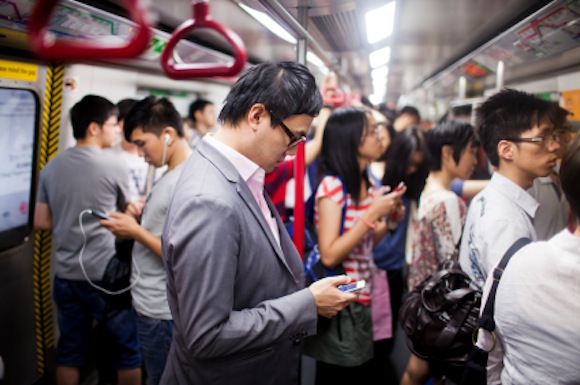
There are seemingly endless things one is not allowed to do on Japanese trains: eat or drink, put on makeup, talk on the phone, take up too much room. Most of these are sensible if strict, making life more pleasant for everybody in a jam-packed carriage. There’s one rule that’s a bit more unusual, though, and that’s the requirement that you switch your phone off near the priority seats.
Mobile phones can interfere with pacemakers, ran the conventional wisdom. So to give passengers with medical equipment a safe haven from electronic interference, most train companies asked passengers to switch phones off completely in certain areas. This summer, rail companies in Kansai more or less ditched that policy, saying it’s no longer necessary. Tokyo, meanwhile, shows no signs of changing the rules.
▼ Phone-free carriages: also great for people who hate technology.
The ‘power off ‘ rule stems from a 2005 recommendation from the Ministry of Internal Affairs and Communications. Rail companies’ implementation of it varies, however: some ask that passengers turn phones off near priority seating; other companies have separate carriages; on some lines, all carriages are designated ‘power off’.
When 2G mobile phones were phased out, though, the danger posed to people with pacemakers all but vanished. Until 2012, the ministry recommended that phones be kept 22cm from a pacemaker – in a crowded train, there was a reasonable possibility of that being breached. Now, the recommendation is 3cm. So in the Kansai area, rail companies dropped the ‘power off’ rule this July, except for at busy times.
▼ Busy times are busy.
In Kantō, however, the area further east including Tokyo that shares a centuries-old rivalry with Kansai, rail companies say they have no intention of relaxing the rules. Kantō’s urban trains are famously crowded, so perhaps that’s part of the thinking, although JR East and Tokyo Metro both cited customer unease as the reason:
“Passengers with pacemakers are [still] uneasy about the use of mobile phones.”
The government, however, has been clear that the old ‘power off’ recommendations were for 2G service, and are not necessary now that it’s no longer used. It seems like there’s a case for educating people that the risks have changed, rather than keeping the rules the same because of passengers’ misconceptions.
▼ Spotted: a phone with an actual antenna.
Source: IT media news
Top image: yumekata

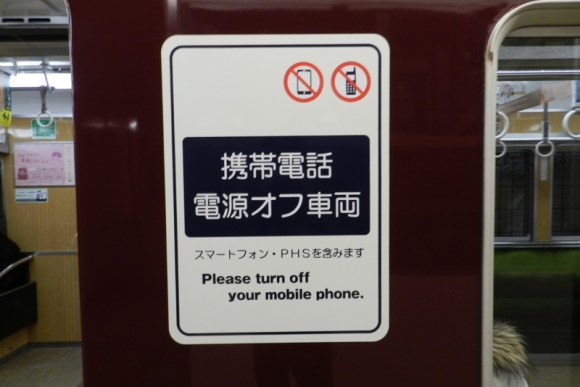
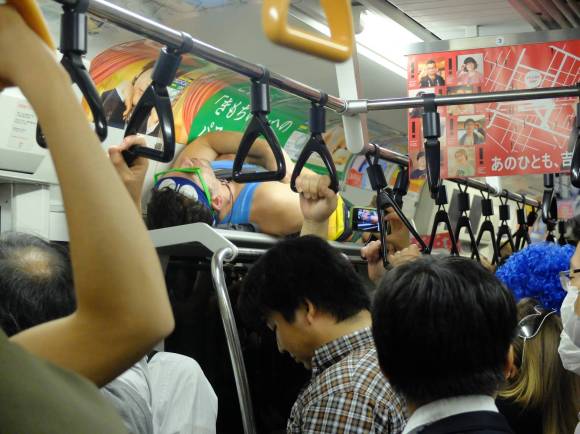
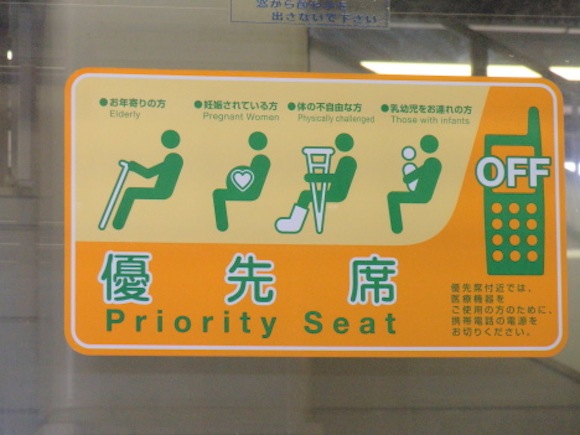
 Tokyo trains to ease cellphone restrictions near priority seats — but not during rush hour
Tokyo trains to ease cellphone restrictions near priority seats — but not during rush hour Inconsiderate commuter behavior in Korea – A photo guide
Inconsiderate commuter behavior in Korea – A photo guide Japanese companies banned from locking cellphone SIM starting this autumn
Japanese companies banned from locking cellphone SIM starting this autumn Shinkansen conductor caught playing GPS smartphone game on bullet train…for TEN years
Shinkansen conductor caught playing GPS smartphone game on bullet train…for TEN years Japan’s Shinkansen bullet trains to remove all onboard payphones
Japan’s Shinkansen bullet trains to remove all onboard payphones Japanese ramen restaurants under pressure from new yen banknotes
Japanese ramen restaurants under pressure from new yen banknotes Tokyo Tsukiji fish market site to be redeveloped with 50,000-seat stadium, hotel, shopping center
Tokyo Tsukiji fish market site to be redeveloped with 50,000-seat stadium, hotel, shopping center McDonald’s new Happy Meals offer up cute and practical Sanrio lifestyle goods
McDonald’s new Happy Meals offer up cute and practical Sanrio lifestyle goods Red light district sushi restaurant in Tokyo shows us just how wrong we were about it
Red light district sushi restaurant in Tokyo shows us just how wrong we were about it Pokémon Sleep camping suite and guestrooms coming to Tokyo Hyatt along with giant Snorlax burgers
Pokémon Sleep camping suite and guestrooms coming to Tokyo Hyatt along with giant Snorlax burgers Beautiful Red and Blue Star luxury trains set to be Japan’s new Hokkaido travel stars
Beautiful Red and Blue Star luxury trains set to be Japan’s new Hokkaido travel stars New private rooms on Tokaido Shinkansen change the way we travel from Tokyo to Kyoto
New private rooms on Tokaido Shinkansen change the way we travel from Tokyo to Kyoto We tried Korea’s way-too-big King Tonkatsu Burger at Lotteria 【Taste Test】
We tried Korea’s way-too-big King Tonkatsu Burger at Lotteria 【Taste Test】 Mt. Koya planning to instate visitor’s tax to cope with huge tourist numbers
Mt. Koya planning to instate visitor’s tax to cope with huge tourist numbers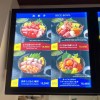 Beware the rise of overpriced “Inbound Don” at tourist spots in Japan
Beware the rise of overpriced “Inbound Don” at tourist spots in Japan All-you-can-drink Starbucks and amazing views part of Tokyo’s new 170 meter-high sky lounge
All-you-can-drink Starbucks and amazing views part of Tokyo’s new 170 meter-high sky lounge More foreign tourists than ever before in history visited Japan last month
More foreign tourists than ever before in history visited Japan last month Starbucks reopens at Shibuya Scramble Crossing with new look and design concept
Starbucks reopens at Shibuya Scramble Crossing with new look and design concept Studio Ghibli releases new action figures featuring Nausicaä of the Valley of the Wind characters
Studio Ghibli releases new action figures featuring Nausicaä of the Valley of the Wind characters French Fries Bread in Tokyo’s Shibuya becomes a hit on social media
French Fries Bread in Tokyo’s Shibuya becomes a hit on social media Studio Ghibli glasses cases let anime characters keep an eye on your spectacles
Studio Ghibli glasses cases let anime characters keep an eye on your spectacles Is the new Shinkansen Train Desk ticket worth it?
Is the new Shinkansen Train Desk ticket worth it? Beautiful Ghibli sealing wax kits let you create accessories and elegant letter decorations【Pics】
Beautiful Ghibli sealing wax kits let you create accessories and elegant letter decorations【Pics】 Studio Ghibli releases Kiki’s Delivery Service chocolate cake pouches in Japan
Studio Ghibli releases Kiki’s Delivery Service chocolate cake pouches in Japan New definition of “Japanese whiskey” goes into effect to prevent fakes from fooling overseas buyers
New definition of “Japanese whiskey” goes into effect to prevent fakes from fooling overseas buyers Our Japanese reporter visits Costco in the U.S., finds super American and very Japanese things
Our Japanese reporter visits Costco in the U.S., finds super American and very Japanese things Studio Ghibli unveils Mother’s Day gift set that captures the love in My Neighbour Totoro
Studio Ghibli unveils Mother’s Day gift set that captures the love in My Neighbour Totoro Domino’s Japan now sells…pizza ears?
Domino’s Japan now sells…pizza ears? New Japanese KitKat flavour stars Sanrio characters, including Hello Kitty
New Japanese KitKat flavour stars Sanrio characters, including Hello Kitty New Pokémon cakes let you eat your way through Pikachu and all the Eevee evolutions
New Pokémon cakes let you eat your way through Pikachu and all the Eevee evolutions Sales of Japan’s most convenient train ticket/shopping payment cards suspended indefinitely
Sales of Japan’s most convenient train ticket/shopping payment cards suspended indefinitely Sold-out Studio Ghibli desktop humidifiers are back so Totoro can help you through the dry season
Sold-out Studio Ghibli desktop humidifiers are back so Totoro can help you through the dry season Japanese government to make first change to romanization spelling rules since the 1950s
Japanese government to make first change to romanization spelling rules since the 1950s Ghibli founders Toshio Suzuki and Hayao Miyazaki contribute to Japanese whisky Totoro label design
Ghibli founders Toshio Suzuki and Hayao Miyazaki contribute to Japanese whisky Totoro label design Doraemon found buried at sea as scene from 1993 anime becomes real life【Photos】
Doraemon found buried at sea as scene from 1993 anime becomes real life【Photos】 Tokyo’s most famous Starbucks is closed
Tokyo’s most famous Starbucks is closed One Piece characters’ nationalities revealed, but fans have mixed opinions
One Piece characters’ nationalities revealed, but fans have mixed opinions We asked a Uniqlo employee what four things we should buy and their suggestions didn’t disappoint
We asked a Uniqlo employee what four things we should buy and their suggestions didn’t disappoint Princesses, fruits, and blacksmiths: Study reveals the 30 most unusual family names in Japan
Princesses, fruits, and blacksmiths: Study reveals the 30 most unusual family names in Japan Auction for “the present I was going to surprise my girlfriend with” closes with a happy ending
Auction for “the present I was going to surprise my girlfriend with” closes with a happy ending Video of foreign diplomat riding in Tokyo subway priority seat sparks manners debate【Video】
Video of foreign diplomat riding in Tokyo subway priority seat sparks manners debate【Video】 “Passengers who don’t want to be groped, please use the rear train cars” announcement angers Japan
“Passengers who don’t want to be groped, please use the rear train cars” announcement angers Japan To sit or not to sit? Linguistic and societal debate on Japanese train seats for the elderly
To sit or not to sit? Linguistic and societal debate on Japanese train seats for the elderly Japan Railways to release new anti-groper smartphone app to help victims before chikan gets away
Japan Railways to release new anti-groper smartphone app to help victims before chikan gets away Reading manga before you buy now officially OK again at Japan’s biggest second-hand bookstore
Reading manga before you buy now officially OK again at Japan’s biggest second-hand bookstore One of Tokyo’s busiest subway lines is adding women-only cars
One of Tokyo’s busiest subway lines is adding women-only cars Japanese government to outlaw carrying unbound knives on trains starting next year
Japanese government to outlaw carrying unbound knives on trains starting next year Should strong-smelling foods be banned from bullet trains? Japanese citizens debate
Should strong-smelling foods be banned from bullet trains? Japanese citizens debate Magical train ride through Japan’s autumn leaves is like travelling to a different world【Video】
Magical train ride through Japan’s autumn leaves is like travelling to a different world【Video】 Woman delivers baby on passenger train just outside of Tokyo
Woman delivers baby on passenger train just outside of Tokyo Nozomi Shinkansen bullet train abolishes low-priced unreserved tickets during peak travel seasons
Nozomi Shinkansen bullet train abolishes low-priced unreserved tickets during peak travel seasons Crushed turtle on tracks delays train in Japan, problem “not uncommon”
Crushed turtle on tracks delays train in Japan, problem “not uncommon” Tokyo’s busiest train stations have a new, free, English-compatible navigation app
Tokyo’s busiest train stations have a new, free, English-compatible navigation app Stranded passengers on Shinkansen bullet train served out-of-date bread during typhoon
Stranded passengers on Shinkansen bullet train served out-of-date bread during typhoon ‘Power harrassment’ in Japan’s police force blamed for officer’s suicide
‘Power harrassment’ in Japan’s police force blamed for officer’s suicide
Leave a Reply